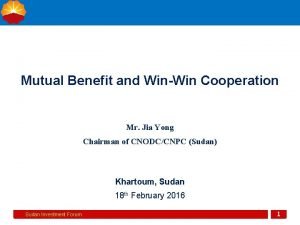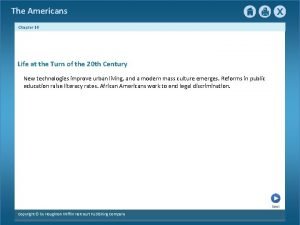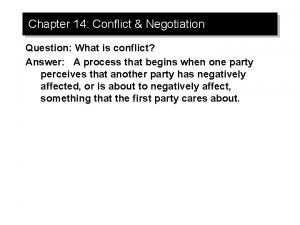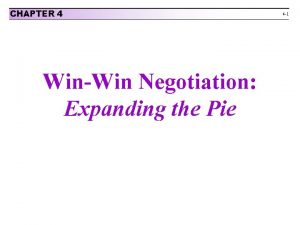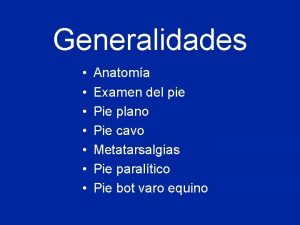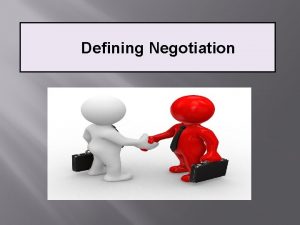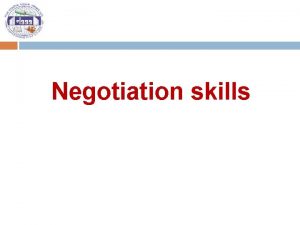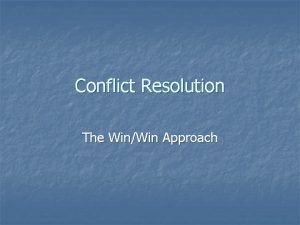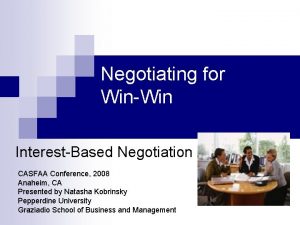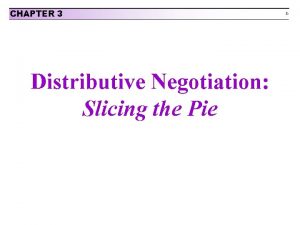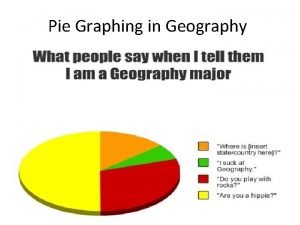CHAPTER 4 WinWin Negotiation Expanding the Pie 4


















- Slides: 18

CHAPTER 4 Win-Win Negotiation: Expanding the Pie 4 -1

CHAPTER 4 4 -2 Faulty Perceptions of Win-Win Negotiation • • Compromise Even split Satisfaction Building a relationship

CHAPTER 4 Win-win really means that all creative opportunities are exploited and no resources are left on the table (integrative negotiation) 4 -3

CHAPTER 4 Telltale Signs of Win-Win Potential • • Does the negotiation contain more than one issue? Can other issues be brought in? Can side deals be made? Do parties have different preferences across negotiation issues? 4 -4

CHAPTER 4 4 -5 Exhibit 4 -1: A Pyramid Model of Integrative Agreements Level 3: Pareto -optimal Level 2: Settlement demonstrably superior to other feasible settlements Level 1: Mutual settlement (positive bargaining zone)

CHAPTER 4 A PYRAMID MODEL (EXHIBIT 4 -1) • Level 1: Agreements that exceed parties’ no-agreement possibilities or reservation points • Level 2: Agreements that are better for both parties than other feasible negotiated agreements (situation is not purely fixed-sum) • Level 3: Agreements that are impossible to improve on from the perspective of both parties (along pareto-optimal frontier of agreement) 4 -6

CHAPTER 4 MOST COMMON PIE-EXPANDING ERRORS • False conflict (also called illusory conflict) ü Lose-lose effect ü How to avoid lose-lose agreements Be aware of the fixed-pie perception Avoid making premature concessions 4 -7

CHAPTER 4 MOST COMMON PIE-EXPANDING ERRORS • Fixed-pie perception ü Negotiators assume interests are incompatible, that impasse is likely, and that issues are settled one by one rather than as packages ü Banishing fixed-pie perception is very difficult; many negotiators fall prey to it and throw money away 4 -8

CHAPTER 4 MOST COMMON PIE-EXPANDING ERRORS • Fixed-pie perception ü Negotiation is not purely competitive; rather, it is a mixed-motive enterprise: cooperation (parties can reach an agreement and avoid resorting to their BATNAs). competition (parties can claim the largest slice of the pie). 4 -9

CHAPTER 4 Expanding the Pie: Strategies That Do Not Work • Commitment to reaching a win-win deal often parties have an incorrect idea about what win-win is • Compromise pertains to slicing the pie, not expanding the pie 4 -10

CHAPTER 4 Expanding the Pie: Strategies That Do Not Work • Focusing on a long-term relationship establishing a long-term relationship does not translate directly into win-win • Adopting a “cooperative orientation” often keeps parties from focusing on the right information at the right time • Taking extra time to negotiate the quality of the negotiation does not improve with additional time 4 -11

CHAPTER 4 4 -12 Exhibit 4 -2: Types of Information in Negotiation and How Each Affects Distributive and Integrative Agreements Type of Information Definition (example) Claiming Value Creating Value BATNA (and reservation price) Position (stated demand) Underlying interests The alternatives a negotiator has outside of the current negotiation (e. g. , “If I don’t buy your car, I can buy my uncle’s car for $2, 000”) Revealing this information severely hurts ability to maximize negotiator surplus Usually, a negotiator’s opening offer; the behavioral manifestation of his/her target point (e. g. , “I will give you $1, 500 for your car”) The underlying needs and reasons a negotiator has for a particular issue (e. g. , “I need a car because I need transportation to my job site, which is 15 miles away in a rural zone”) Priorities A judgment about the relative importance of the issues to a negotiator (e. g. , “I am more concerned about the down payment than I am about the financing for the car”) Key facts Pertains to information that bears on the quality and the value of the to-be-negotiated issues (e. g. , “The car has a rebuilt engine and has been involved in a major collision; ” “The oranges are genetically modified”) Argument either made to support one’s own position or to attack the other party’s position (e. g. , “You will get lots of dates if you buy my car because women like it”) Opening with an aggressive target point significantly increases the negotiator’s surplus (share of the bargaining zone) Revealing this information generally increases likelihood of obtaining a favorable slice of the pie because negotiators who provide a rationale for their demands are more adept at realizing their targets Increases a negotiator’s surplus indirectly, because if more value is created via sharing priorities, then the probability that a negotiator will get a larger slice of the pie increases This information can affect the slice of the pie the negotiator obtains in that facts either increase or decrease the value of the to-be-negotiated issues Revealing or obtaining this information does not affect ability to reach level 2 or 3 integrative agreements; might help negotiators reach level 1 integrative agreements Does not affect integrative agreements Substantiatio n Most dominant type of distributive tactic (24% to 27% of all statements); ** can increase a negotiator’s slice of the pie because providing a rationale (even an absurd one) can often be effective in obtaining a demand Very important for reaching win-win deals; by (truthfully) revealing underlying interests, negotiators can discover win-win agreements (e. g. , one sister tells the other that she wants the orange because she needs to make juice and has no need for rinds) Vitally important for maximizing the pie (e. g. , the sister who said she cared more about the rinds relative to the juice created potential for integrative agreement) Affects the quality of win-win agreements in that failure to reveal key information may lead a negotiator to overor undervalue a particular resource (e. g. , someone who sells “fresh organic orange juice” does not want to have genetically-modified oranges as an ingredient) A distributive tactic; does not increase win-win negotiation and may, in fact, reduce likelihood of winwin* • Pruitt, D. G. , (1981). Negotiation Behavior. New York: Academic Press; Hyder, E. B. , Prietula, M. J. , & Weingart, L. R. (2000). Getting to best: Efficiency versus optimality in negotiation. Cognitive Science, 24(2), 169– 204. ** Carnevale, P. J. , & Lawler, E. J. (1986). Time pressure and the development of integrative agreements in bilateral negotiations. Journal of Conflict Resolution, 30(4), 636– 659.

CHAPTER 4 4 -13 Expanding the Pie: Strategies That Work • Perspective-taking • Ask questions about interests and priorities • Provide information about your interests and priorities • Unbundle the issues • Make package deals, not single-issue offers • Make multiple offers of equivalent value simultaneously

CHAPTER 4 4 -14 Expanding the Pie: Strategies That Work • Structure contingency contracts by capitalizing on differences ü Valuation ü Expectations ü Risk attitudes ü Time preferences ü Capabilities ü Cautionary note on effective contingency contracts • Presettlements (Pre. SS) • Postsettlements

CHAPTER 4 4 -15 A STRATEGIC FRAMEWORK FOR REACHING INTEGRATIVE AGREEMENTS • Resource assessment ü Specify issue mix ü Unbundle issues and alternatives • • Assessment of differences Offers and trade-offs Acceptance/rejection decision Prolonging negotiation and renegotiation

CHAPTER 4 4 -16 Exhibit 4 -6: Decision-Making Model of Integrative Negotiation not acceptable (optimistic) not acceptable (bleak) Resource Assessment of Differences Construct Offers and Trade-Offs Current “Best” Terms both agree Postsettlement Settlements Implement Agreement Impasse

CHAPTER 4 DO NOT FORGET ABOUT CLAIMING • Not an effective strategy to just focus on expanding the pie; negotiator must also focus on claiming resources • Three stages in evolution of integrative negotiator ü “Old-fashioned” negotiator—comes from the old school of bargaining and adopts a tough, hard stance ü “Flower child” negotiator—so busy expanding the pie that forgets to claim resources ü “Enlightened” negotiator—negotiator claims resources and protects own interests while expanding the pie 4 -17

CHAPTER 4 4 -18 CONCLUSION • All negotiators want to reach win-win agreements, however, most fail to do so • Negotiators are usually not aware that their outcomes are inefficient • Key reasons for lose-lose outcomes are illusory conflict and the fixed-pie perception • In attempts to expand the pie, negotiators should not forget about claiming resources
 Thompson pyramid model of integrative agreements
Thompson pyramid model of integrative agreements Diagram lingkaran excel
Diagram lingkaran excel Think win win stephen covey
Think win win stephen covey Win win situation examples
Win win situation examples Winwin south sudan
Winwin south sudan Think winwin
Think winwin Chapter 9 expanding markets and moving west
Chapter 9 expanding markets and moving west Chapter 16 section 2 expanding public education
Chapter 16 section 2 expanding public education Chapter 9 expanding markets and moving west
Chapter 9 expanding markets and moving west Chapter 9 expanding markets and moving west
Chapter 9 expanding markets and moving west Integrative negotiation
Integrative negotiation Pie chart the great gatsby chapter 9 blame chart answers
Pie chart the great gatsby chapter 9 blame chart answers Hình ảnh bộ gõ cơ thể búng tay
Hình ảnh bộ gõ cơ thể búng tay Frameset trong html5
Frameset trong html5 Bổ thể
Bổ thể Tỉ lệ cơ thể trẻ em
Tỉ lệ cơ thể trẻ em Gấu đi như thế nào
Gấu đi như thế nào Chụp tư thế worms-breton
Chụp tư thế worms-breton Bài hát chúa yêu trần thế alleluia
Bài hát chúa yêu trần thế alleluia




